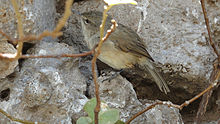| Nihoa millerbird | |
|---|---|

| |
| On the island of Nihoa, Northwestern Hawaiian Islands | |
| Scientific classification | |
| Domain: | Eukaryota |
| Kingdom: | Animalia |
| Phylum: | Chordata |
| Class: | Aves |
| Order: | Passeriformes |
| Family: | Acrocephalidae |
| Genus: | Acrocephalus |
| Species: | |
| Subspecies: | A. f. kingi
|
| Trinomial name | |
| Acrocephalus familiaris kingi (Wetmore, 1923)
| |
The Nihoa millerbird (Acrocephalus familiaris kingi) is a subspecies of the millerbird. It gets its name from its preferred food, the Miller moth. The 5-inch (13 cm) long millerbird has dark, sepia-colored feathers, white belly, and dark beak. Its natural geographic range is limited to the tiny island of Nihoa in the Northwestern Hawaiian Islands, and it is hoped that birds translocated to Laysan will help to ensure the survival of the species. The Nihoa millerbird is one of the two endemic birds remaining on Nihoa, the other being the Nihoa finch.
Only 200– 900 Nihoa millerbirds persist on the island, making the species seriously endangered. It is always at risk of extinction from environmental changes (droughts, fires, insect population irruptions), because flight away from the island would likely prove fatal. The Laysan millerbird, now extinct, was closely related.[1]
The trinomial commemorates Samuel Wilder King, captain of the Tanager Expedition and later Governor of Hawaii.

